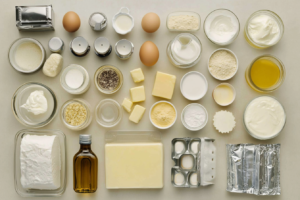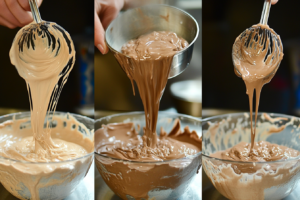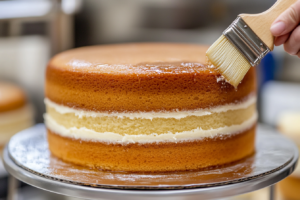Introduction
Understanding What Is the Secret to Super Moist Cake
Discovering What Makes a Cake Super Moist?
To uncover what makes a cake moist and fluffy, we need to understand the science of moisture in cakes. By balancing liquid ingredients, fats, and specific techniques, you can achieve that super moist cake texture.
Why Moisture Matters in Cakes
Moisture plays a significant role in flavor, texture, and the overall enjoyment of a cake. No one wants a dry, crumbly cake—by focusing on what makes a cake super moist, you create a dessert that holds onto its flavor and remains soft. Let’s look at how to prevent dryness and maintain that super moist cake texture.
Common Challenges That Lead to Dry Cakes
There are several pitfalls to avoid if you want a perfectly moist cake. Here are some of the most common mistakes that result in dry cakes:
- Overbaking: The longer you bake a cake, the drier it gets. Even a few extra minutes can zap moisture right out of your batter.
- Incorrect Measurements: Baking is a science, and even small measurement errors can affect your cake’s texture. Too much flour, for instance, can make your cake dry.
- Low-Quality Ingredients: The quality of your butter, oil, and even sugar can impact the moisture of your cake.
Now that we understand the basics of moisture in cakes, let’s dig into the ingredients that can help make each bite of your cake deliciously moist.
Essential Ingredients for a Super Moist Cake

Fats and Oils: The Heart of What Keeps a Cake Moist
In the quest to uncover what keeps a cake moist, fats and oils are essential ingredients. Butter and oil each bring different qualities, with oil being especially effective for maintaining that moist cake texture.
- Butter adds a rich flavor that’s hard to beat. Its water content also helps create steam during baking, which contributes to a tender crumb. However, too much butter can actually make a cake denser, so balance is key.
- Vegetable oil is often praised for its moisture-retaining qualities. Unlike butter, oil doesn’t solidify when it cools, which helps keep the cake moist longer. This is why you’ll often find oil used in recipes where an ultra-moist texture is desired.
Using a mix of both butter and oil can yield the best of both worlds: a richly flavored cake that stays moist for days. Experiment with a balance of fats to see which works best for your recipe.
Dairy Products: Key Ingredients in Making a Cake Moist and Fluffy
Dairy ingredients like buttermilk and sour cream are crucial to making a cake moist and fluffy. Their natural fat content and acidity contribute to the soft, tender crumb that defines a super moist cake.
- Buttermilk: Known for adding a slight tang and softness to baked goods, buttermilk contains acids that tenderize gluten in the flour, making for a lighter, softer cake.
- Sour Cream: A little sour cream goes a long way in enriching the texture of your cake. The high-fat content of sour cream keeps the cake extra moist and adds a subtle tang, which can enhance flavors in chocolate or vanilla cakes.
- Yogurt: Similar to sour cream, yogurt adds moisture and can even help with leavening due to its acidity. Greek yogurt, in particular, works wonders in cake recipes, lending both moisture and a dense, yet soft texture.
Using these dairy ingredients in your recipes can make a noticeable difference, transforming an average cake into a bakery-quality creation.
Sugars and Sweeteners: More Than Just Sweetness
Sugar is a powerful ingredient when it comes to cake moisture. In addition to sweetening, sugar is hygroscopic, meaning it attracts and holds onto water. This property helps keep cakes moist and prevents them from drying out quickly.
- Granulated Sugar is commonly used, but incorporating a portion of brown sugar can increase moisture even further, thanks to the molasses in it. Brown sugar also brings a deeper flavor that can complement richer cakes, like moist chocolate cake or banana cake.
Other sweeteners, like honey or even corn syrup, can be used in small amounts to help lock in moisture. Just be mindful of the sweetness level, as too much sugar can overpower the other flavors.
Alternative Moisture-Enhancing Ingredients
Sometimes, unique ingredients can add unexpected moisture to cakes, enhancing both texture and taste:
- Mayonnaise: Believe it or not, adding a bit of mayo to your batter works wonders, especially in chocolate cakes. Made of eggs and oil, it brings extra richness and moisture.
- Applesauce: Not only does applesauce act as a healthy alternative to oil or butter, but it also infuses moisture without altering the cake’s flavor.
- Bananas, Beets, and Other Fruits: Pureed fruits are naturally moist and can add unique flavors to cakes. For example, mashed bananas are perfect in banana cakes, while pureed beets can enhance chocolate cakes.
With the right ingredients, you can ensure your cake stays moist, flavorful, and ready to impress. In the next section, we’ll cover essential techniques that go hand-in-hand with these ingredients to perfect your baking game.
Techniques for Achieving a Super Moist Cake

Mixing Techniques to Make a Cake Moist
Proper mixing techniques are a big part of what is the secret to super moist cake. Overmixing can lead to dryness, while folding and gentle mixing retain moisture, helping to create a cake that’s tender and moist.
- Creaming Butter and Sugar: Begin by creaming the butter and sugar together until they’re light and fluffy. This step adds air to the batter, which helps make the cake lighter. Make sure you’re mixing just enough for everything to blend smoothly.
- Folding in Dry Ingredients: When adding dry ingredients like flour, use a gentle folding technique. Folding prevents overmixing while still ensuring that the ingredients are evenly distributed. This technique is especially important when using delicate ingredients like whipped egg whites.
Being mindful of how you mix helps create a batter that’s full of air without activating too much gluten—an essential step for a fluffy and moist cake.
Accurate Measurements and Baking Time for Moist Cake Results
Baking a perfectly moist cake requires accurate measurements and the right baking time. These details play an essential role in what makes a cake moist, ensuring you achieve a cake that’s not too dry or dense.
- Use a Kitchen Scale: Measuring by weight is far more accurate than using measuring cups, especially for flour. Too much flour is one of the most common reasons cakes turn out dry.
- Measure Liquids Carefully: For liquids, use a clear measuring cup and ensure you’re measuring at eye level. Even a little extra milk or oil can impact the final texture of your cake.
Precise measurements help ensure that every ingredient does its job without throwing off the delicate balance that produces a moist, tender crumb.
Optimal Baking Temperatures and Times: Don’t Rush the Process
Getting the temperature and timing right is vital in baking. Even the best recipe can fall flat if the cake bakes too long or at the wrong temperature.
- Preheat the Oven: Always preheat your oven fully before placing the cake inside. Starting with a cold oven means your cake won’t bake evenly, often leading to dryness in some parts.
- Set the Correct Baking Time: Pay close attention to baking times. Start checking for doneness a few minutes before the recipe suggests. Insert a toothpick into the center—if it comes out mostly clean or with just a few crumbs, your cake is ready. Don’t wait for the toothpick to be completely dry, as this can lead to overbaking.
Cooling and Storage Practices to Retain Moisture
How you cool and store your cake is just as important as the baking process when it comes to retaining moisture.
- Cooling on a Rack: Allow your cake to cool on a wire rack to let air circulate around it, which prevents soggy bottoms. However, avoid leaving it out too long, as it can start to dry out.
- Wrapping and Storing: Once the cake is cooled, wrap it tightly in plastic wrap or store it in an airtight container to lock in moisture. If you’re not eating it the same day, consider refrigerating or freezing it, as this can actually help maintain moisture.
With the right techniques, you can make sure your cake comes out moist, tender, and bakery-perfect. Next, let’s explore how to take moisture to the next level with syrups and fillings.
Using Syrups and Fillings to Keep Cake Moist

Applying Simple Syrups: What Makes Cake Layers Super Moist
Brushing simple syrup on cake layers is a well-known trick for what makes cake layers super moist. It enhances flavor and keeps each layer soft, especially if you’re preparing the cake ahead of time.
- How to Make Simple Syrup: Combine equal parts sugar and water, then heat until the sugar dissolves. You can flavor it with vanilla, almond, citrus zest, or even a splash of coffee for a customized touch.
- Brushing Technique: After the cake has cooled slightly, use a pastry brush to apply a thin layer of syrup over the cake layers. This step helps lock in moisture, making every bite just a little bit sweeter and softer.
Using simple syrup is especially helpful if you’re baking ahead of time or need to store the cake overnight, as it keeps the cake from drying out.
Moisture-Rich Fillings and Frostings
Beyond the cake itself, the right fillings and frostings can significantly boost a cake’s moisture level. Opt for fillings and frostings that are moisture-rich, and apply them generously between layers and on top to keep the entire cake deliciously soft.
- Buttercream and Cream Cheese Frosting: These are classic options that not only add flavor but also help protect the cake layers from drying out by creating a sealed barrier.
- Ganache: Made from cream and chocolate, ganache is not only luxurious but also retains moisture due to its creamy texture. A thin layer between cake layers or a drizzle on top can work wonders.
- Fruit Fillings: Pureed fruits, jams, and compotes are fantastic for adding moisture and flavor to cakes. These work particularly well with cakes like moist vanilla or chocolate, as they offer a sweet, tangy contrast.
Choosing fillings and frostings wisely can elevate your cake’s texture and add a burst of flavor in every layer. The next section addresses common questions to further guide your baking journey.
FAQs About What is the Secret to Super Moist Cake
What Makes a Cake Moist and Fluffy?
The secret to what makes a cake moist and fluffy lies in balancing ingredients and baking techniques that prevent dryness and enhance texture.
Can oil replace butter to keep cake moist?
Oil is a fantastic option for what makes a cake super moist, as it doesn’t solidify when cooled, ensuring the cake remains soft and tender.
How Can I Keep My Cake Moist Overnight?
To keep your cake moist overnight, let it cool completely, then wrap it tightly in plastic wrap. You can also place it in an airtight container if it has already been frosted. If the cake is unfrosted and you’d like extra assurance, brush each layer with a bit of simple syrup before wrapping. This method locks in moisture and ensures your cake is soft and fresh the next day.
Why Did My Cake Turn Out Dry Even Though I Followed the Recipe?
Even if you followed the recipe, small changes can affect the cake’s texture. Overbaking is one of the most common reasons cakes turn out dry—check your cake a few minutes before the timer goes off. Another reason might be inaccurate measurements, especially with flour. Lastly, make sure not to skip moistening ingredients like oil or dairy products, as they’re key to a soft crumb.
Is It Possible to Make a Moist Cake Without Eggs?
Yes, you can make a moist cake without eggs by using egg substitutes like applesauce, mashed bananas, yogurt, or even vinegar with baking soda. These ingredients not only replace eggs but also add moisture and tenderness to the cake. Using these alternatives can be especially helpful for those following a vegan diet or with egg allergies.


5 thoughts on “What is the Secret to Super Moist Cake?”